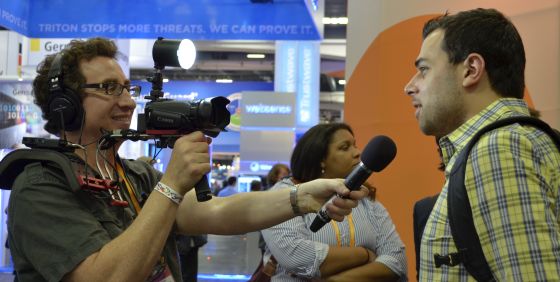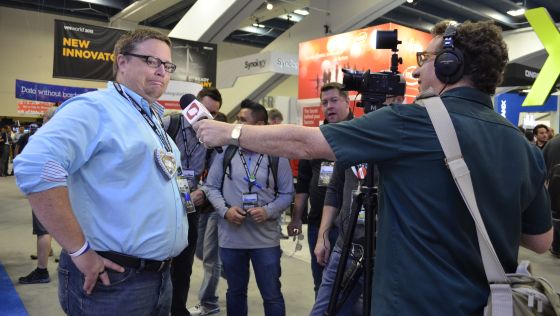A while back I started a short-lived podcast series called “Hacking Media Production.” In that series, I interviewed other media producers and simply asked them the question, how do you produce better content faster? After 20 episodes, I compiled a “best of” list of the top 55 tips I learned from those interviews.
 The advice in those episodes is a mishmash of content production tips. Most content producers are simply dealing with just trying to get more blog posts and videos published. From our nine years producing media, mostly in the B2B space, we’ve refined many different production processes. The advice below is primarily gathered from our experience reporting at conferences with near-immediate turn-around publication expectations. Here are our tips.
The advice in those episodes is a mishmash of content production tips. Most content producers are simply dealing with just trying to get more blog posts and videos published. From our nine years producing media, mostly in the B2B space, we’ve refined many different production processes. The advice below is primarily gathered from our experience reporting at conferences with near-immediate turn-around publication expectations. Here are our tips.
Capture content at live events
For our style of B2B content production, we’ve discovered there’s no faster way to get more content in a short amount of time than reporting at industry events. All your resources are physically within arm’s reach. There’s often no need to go through media relations to clear an interview. And you can get dozens of interviews for a fraction of the time and cost than if you had to meet the key players on an individual basis.
Assembly line your content
Look at your production process like an assembly line. Where are there slow points? If you’ve got real problems you’ll shave hours if not days. When you’ve got a more refined system you’re looking at shaving minutes. If you find enough “minute shaving” moments, that will add up to an hour, and when you’re working a live event, that’s huge.
Here are just a few examples of how we shave minutes producing content at a live event:
- Pre-write blog posts (as much as we know beforehand).
- Use a computer with an SSD or a tablet and keyboard with instant on. This is necessary given the number of times you’ll need to turn your device on and off and be ready to write.
- Capture photos with a mobile phone or a camera with an Eye-Fi card. Both can automatically send photos to the cloud, eliminating the need to manually migrate images from your devices to your computer. As a bonus, the rest of your production team can start sorting, processing, and posting those images back at the office, while you continue to document the live event.
Develop repeatable formats
One of the main reasons we can produce so much content quickly is because we develop easily repeatable formats. Do you find that certain types of your content work better than others? Why not hone in on that style? What makes it so popular? How can you make it better in terms of quality and speed of production?
Summarize a panel session as a list of quotes or moments
Panel sessions are a common staple at any conference. They are also consistently non-linear conversations. I’ve read many articles that try to “sum up” the discussion of a panel. It’s a noble effort to try to find a singular theme of the conversation. As a writer, you can do that, and it will take you a lot more time. But the reality is most people only get nuggets of information out of a panel, as evidenced by the number of tweets where people just echo what someone else said on a panel.
We use the following simple format for writing blog posts about panel discussions. Include the title of the panel and all the people in it with respective titles, companies, and links (you can prewrite that), and then just write, “Here are some of the items that came up in the discussion.” Then just keep a bulleted list of quotes or issues that came up.
When you’re done creating that bulleted list, you’re done. That’s a blog post, and it’s valuable because it has the relevant information that came out of the panel in a quickly readable format.
Use text expanders
Next week I’m going to be going to the RSA Conference 2016 in San Francisco. I’ll be writing the name of the conference over and over again in the 20+ blog posts I end up publishing. To save myself a few seconds for each post, I’ll create a macro, such as “rs.” If I just type those two letters and hit the tab key, it will automatically expand to be “RSA Conference 2016 in San Francisco” with the text already hyperlinked to the conference website.
Learn how to log video using your keyboard
Those who work in video production know that logging video can be an enormous time suck. I used to log video using a mouse and keyboard, until my video editor showed me how to use shortcut keys to quickly fast forward, rewind, mark ins and outs, and drop the clips into the timeline without ever having to pick up the mouse. It’s amazing how much time it saves. If you deal with video, you absolutely must learn how to log video just using the keyboard.
Lynda.com has an entire lesson on the topic for users of Premiere Pro.
Prep your equipment
Ask yourself:
- Do you have all the necessary applications on your computer?
- Do you have easy to access icons?
- Are all your batteries charged?
- Is every device, battery, and peripheral in places you know where to find them?
- Are you automatically logged into all your accounts or do you at least have a password management program that can automatically log into sites for you?
- Do you have backups of everything? What happens if one of your items breaks? For example, I have a plastic device that costs $7 and holds my light to my camera. It’s plastic and it can break. It has broken. I survived because I had a backup.
It only takes one failure for you to realize you should have prepped and tested all your equipment. Don’t wait for that moment. Start doing it now.

Have fast approval systems in place
If you work at an organization that has legal issues around content or just has many approval systems in place, you simply can’t take advantage of moments in real time if you don’t either trust/train content producers or have an extremely fast approval process in place.
When possible, I’m always a fan of training content staff beforehand so they don’t have to go through a lengthy approval process. But if that’s not possible, streamline that process because if you’re trying to time content as news events are breaking, and you can’t get it out because someone is not available to approve it, the opportunity is lost.
For more, read “Bad Timing is the Death of Comedy… and Content Marketing.”
Don’t move… that much
What is it about where you are physically? The less you have to physically move, the faster you can produce content. Look at your environment and see if you can be as close to the action as possible and you can keep your equipment on and in a safe place.
Your fast production tips?
Got any for me and fellow readers?




